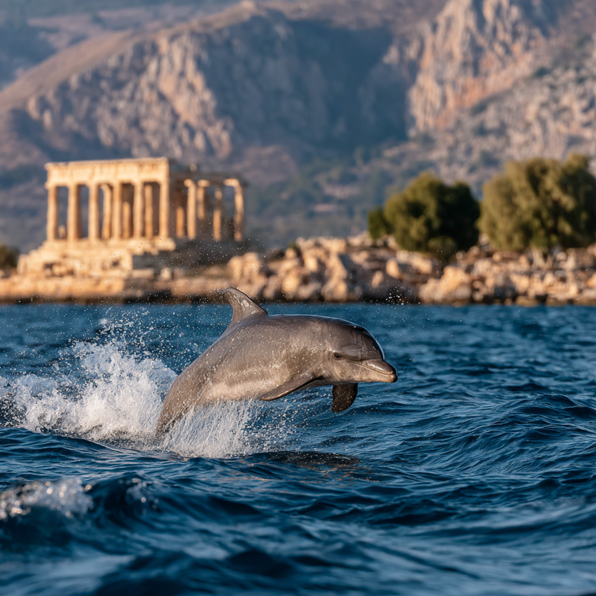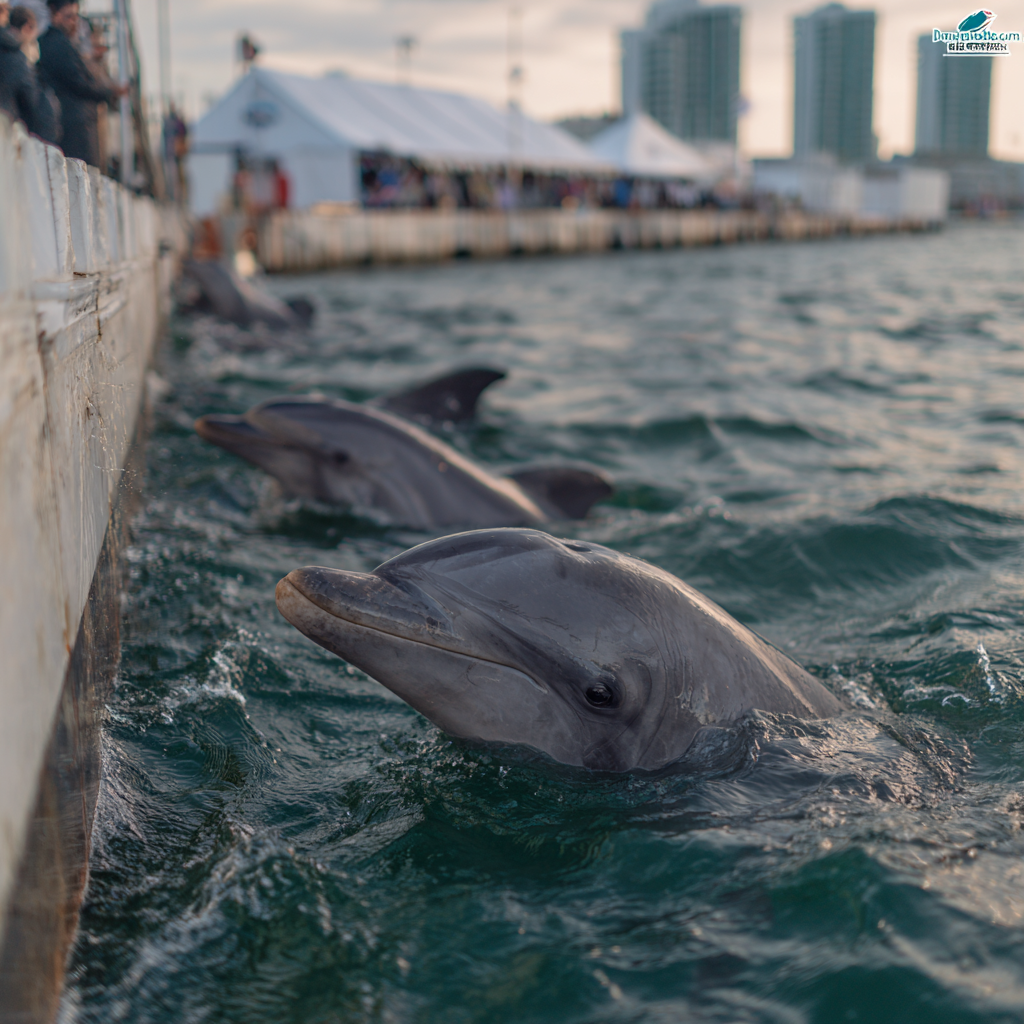Overview
The bottlenose dolphin is perhaps the most recognizable and beloved of all cetaceans, known for its intelligence, playful behavior, and distinctive "smile." Found in temperate and tropical waters worldwide, these charismatic dolphins have captured human imagination for millennia, appearing in ancient Greek art and modern marine parks alike.
With their remarkable cognitive abilities, complex social structures, and adaptability to various marine environments, bottlenose dolphins represent both the wonder and the ethical complexities of our relationship with marine mammals. They challenge us to consider questions of consciousness, communication, and what we owe to species that may share more with us than we once believed.

The iconic bottlenose dolphin, displaying the characteristic curved mouth that appears as a permanent smile
Intelligence and Cognition
Bottlenose dolphins possess one of the largest brain-to-body ratios of any animal, second only to humans. Their cognitive abilities are extraordinary: they can recognize themselves in mirrors, use tools, understand symbolic language, and demonstrate cultural transmission of behaviors across generations.
Research has documented dolphins using marine sponges as foraging tools—a behavior passed from mothers to daughters in specific populations. They can comprehend complex syntax in artificial languages, understand pointing gestures, and even create signature whistles that function as individual names.

Bottlenose dolphins live in complex social groups called pods, maintaining long-term relationships
Social Complexity
Bottlenose dolphins live in fission-fusion societies, where group composition changes frequently but certain relationships endure for decades. Males form long-lasting alliances that cooperate in mating strategies, while females maintain networks centered around raising calves. Their social lives rival those of great apes in complexity.
They display empathy and cooperation, have been observed supporting injured companions at the surface to breathe, and engage in apparently altruistic behaviors toward other species, including humans. Their complex vocalizations include signature whistles, burst-pulse sounds, and echolocation clicks used for communication and hunting.
The Captivity Controversy
Few species have sparked more debate about the ethics of captivity than bottlenose dolphins. Their intelligence, self-awareness, and complex social needs raise profound questions about whether keeping them in marine parks and aquariums can ever be justified, even for educational or conservation purposes.
The Dolphin-Assisted Therapy Debate
Dolphin-assisted therapy (DAT) has been promoted for treating various conditions, particularly in children with disabilities. However, scientific research has consistently found no evidence that interactions with dolphins provide therapeutic benefits beyond those of other enjoyable activities, while raising concerns about both human safety and dolphin welfare.
Studies examining DAT programs have revealed methodological flaws, lack of control groups, and no demonstrated long-term benefits. Meanwhile, the practice subjects dolphins to chronic stress and humans to potential injury from wild animals that, despite their friendly reputation, are powerful predators capable of aggressive behavior.

Wild bottlenose dolphins exhibit natural behaviors impossible to replicate in captivity
Conservation Status
Bottlenose dolphins are listed as Least Concern globally by the IUCN, but this designation masks significant regional variations and ongoing threats. Some populations, particularly those in coastal areas or specific regions, face serious challenges from habitat degradation, pollution, and fisheries interactions.
Threats
Bycatch: Incidental capture in fishing gear remains one of the primary threats, particularly in gillnet fisheries. Thousands of dolphins die each year as unintended bycatch.
Pollution: As top predators, dolphins accumulate high levels of persistent organic pollutants, heavy metals, and plastic-derived chemicals. These contaminants can impair immune function, reproduction, and overall health.
Habitat degradation: Coastal development, noise pollution, and declining prey populations affect dolphins dependent on nearshore environments. Boat traffic and harassment from tourism can disrupt feeding and resting behaviors.
Climate change: Warming oceans are shifting prey distributions and may impact dolphin populations, though they show some adaptability to changing conditions.
Cultural Significance
Bottlenose dolphins hold a unique place in human culture, appearing in art, literature, and mythology for thousands of years. Ancient Greeks considered them sacred to Apollo and Poseidon, depicting them in frescoes and on coins. Stories of dolphins rescuing drowning sailors span cultures and centuries.
In modern times, they have become ambassadors for ocean conservation, their intelligence and apparent friendliness making them powerful symbols. Yet this very popularity has led to ethical dilemmas about captivity, tourism, and our responsibility toward species that seem to seek out human contact.
The bottlenose dolphin reminds us that intelligence and consciousness exist in forms vastly different from our own, challenging us to expand our moral consideration and reconsider our relationship with the more-than-human world.
References
- Wells, R.S. & Scott, M.D. Bottlenose dolphin Tursiops truncatus (Montagu, 1821). In W.F. Perrin et al. (Eds.), Encyclopedia of Marine Mammals (2nd ed., pp. 122-128). Academic Press (2009). https://www.sciencedirect.com/science/article/pii/B9780123735539001055
- Connor, R.C. et al. Male dolphin alliances in Shark Bay: Changing perspectives in a 30-year study. Animal Behaviour 103: 223-235 (2015). https://www.sciencedirect.com/science/article/abs/pii/S0003347215000925
- Reiss, D. & Marino, L. Mirror self-recognition in the bottlenose dolphin: A case of cognitive convergence. Proceedings of the National Academy of Sciences 98(10): 5937-5942 (2001). https://www.pnas.org/doi/full/10.1073/pnas.101086398
- Krützen, M. et al. Cultural transmission of tool use in bottlenose dolphins. Proceedings of the National Academy of Sciences 102(25): 8939-8943 (2005). https://www.pnas.org/doi/full/10.1073/pnas.0500232102
- Janik, V.M. et al. Signature whistle shape conveys identity information to bottlenose dolphins. Proceedings of the National Academy of Sciences 103(21): 8293-8297 (2006). https://www.pnas.org/doi/full/10.1073/pnas.0509918103
- Herman, L.M. et al. Comprehension of sentences by bottlenosed dolphins. Cognition 16(2): 129-219 (1984). https://www.sciencedirect.com/science/article/abs/pii/0010027784900035
- Connor, R.C. et al. Social evolution in toothed whales. Trends in Ecology & Evolution 13(6): 228-232 (1998). https://www.sciencedirect.com/science/article/abs/pii/S0169534798013266
- Mann, J. & Sargeant, B. Like mother, like calf: The ontogeny of foraging traditions in wild Indian Ocean bottlenose dolphins (Tursiops sp.). In J. Mann et al. (Eds.), Cetacean Societies: Field Studies of Dolphins and Whales (pp. 91-126). University of Chicago Press (2000). https://press.uchicago.edu/ucp/books/book/chicago/C/bo3630637.html
- Marino, L. & Lilienfeld, S.O. Dolphin-assisted therapy: More flawed data and more flawed conclusions. Anthrozoös 20(3): 239-249 (2007). https://www.tandfonline.com/doi/abs/10.2752/089279307X224782
- Read, A.J. et al. Bycatch of marine mammals in U.S. and global fisheries. Conservation Biology 20(1): 163-169 (2006). https://conbio.onlinelibrary.wiley.com/doi/abs/10.1111/j.1523-1739.2006.00338.x
- Lewison, R.L. et al. Understanding impacts of fisheries bycatch on marine megafauna. Trends in Ecology & Evolution 19(11): 598-604 (2004). https://www.sciencedirect.com/science/article/abs/pii/S0169534704002642
- NOAA Fisheries. Bottlenose Dolphin. https://www.fisheries.noaa.gov/species/bottlenose-dolphin
- Whale and Dolphin Conservation. Bottlenose Dolphin. https://us.whales.org/whales-dolphins/species-guide/bottlenose-dolphin/
- Herodotus. The Histories, Book I (c. 440 BCE). Translated by A.D. Godley. Loeb Classical Library, Harvard University Press (1920). http://www.perseus.tufts.edu/hopper/text?doc=Perseus:text:1999.01.0126:book%3D1